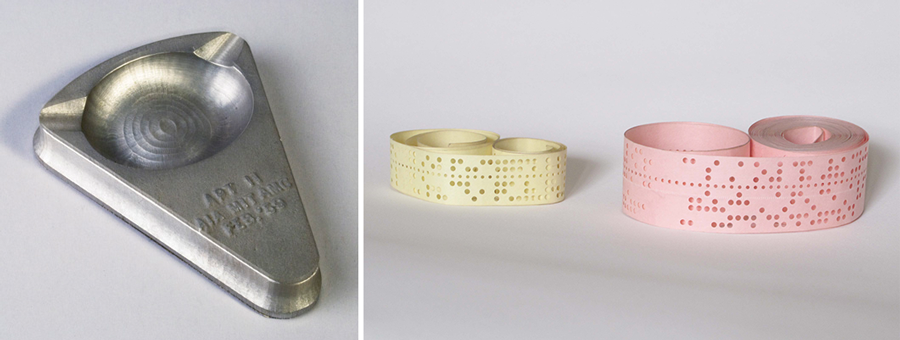Have you ever wondered about the first-ever CNC machine? Maybe you’ve thought about it while sitting at the machine or perhaps it didn’t even dawn on you at all! Well, either way, you are in luck because we did some digging and found some cool facts to share with you. Let’s take it back to the late 1940s for today’s Manufacturing Milestone from BobCAD-CAM.
The year was 1949 when John Parsons had begun researching ways to improve aircraft. This eventually led to a variety of important Air Force-funded research projects that were conducted at the Massachusetts Institute of Technology (MIT). After the planning and research concluded, an experimental Milling machine was developed. Professor J.F. Reintjes and his team lead this groundbreaking research [1].
Worth the Wait
This aluminum ashtray represents a revolution in the machine tool industry. For the first time, complex part geometry could be manufactured by a machine that was controlled by a computer. Program instructions were loaded into the computer’s memory by punched tape. The development of this NC machine took the greater part of a decade and led the way for future developments in manufacturing technology [2].

Necessity is the Mother of Innovation
 Unfortunately, due to the cost of the machine, upwards of $2 million in today’s dollars, the Air Force dumped the project. Parson’s development on NC machines was halted and the future of computer-controlled equipment was cloudy. Fortunately, a small machine tool company located in Fond du Lac, Wisconsin stepped in. Can you guess who it was? That’s right, it was Giddings & Lewis and they reduced costs and improved quality & efficiency. Their efforts led to major advancements in computer-controlled equipment. Without the early development from people and companies like Parsons and G&L, we wouldn’t have modern CNC machines that are so integral in today’s manufacturing environment [3].
Unfortunately, due to the cost of the machine, upwards of $2 million in today’s dollars, the Air Force dumped the project. Parson’s development on NC machines was halted and the future of computer-controlled equipment was cloudy. Fortunately, a small machine tool company located in Fond du Lac, Wisconsin stepped in. Can you guess who it was? That’s right, it was Giddings & Lewis and they reduced costs and improved quality & efficiency. Their efforts led to major advancements in computer-controlled equipment. Without the early development from people and companies like Parsons and G&L, we wouldn’t have modern CNC machines that are so integral in today’s manufacturing environment [3].
Get Your BobCAD-CAM Trial Version Here & Start Cutting Today
You’re one click away from subscribing to BobCAD’s YouTube channel. Click the link below for tips, how-tos and much more!
BobCAD-CAM has provided CAD-CAM CNC Software products to the global manufacturing industry for over 30 years. BobCAD-CAM software can be found to increase CNC productivity for many applications in aerospace, automotive, production manufacturing, mold making, general machining, woodworking as well as the medical manufacturing industry, consumer products, musical instruments, custom fabrication, defense industry and many others due to the products ability to automatically generate NC programming code for such a wide variety of CNC controllers. BobCAD-CAM software is also found in educational institutions throughout the world as well as independent hobby home use. Products include machining technology for 2, 3, 4 & 5 Axis CNC Milling, Routing, Waterjet, Plasma and Laser machines as well as 2 Axis CNC Lathe. BobCAD-CAM is modular allowing shops to start off at a reduced technology level and add technology as it is needed including an add-on, BobART, for artistic machining. Unique technology includes adaptive high-speed machining multiaxis milling and routing which is a first in the world of CAD-CAM software. BobCAD-CAM also provides a variety of quality training products that include regional and online training classes or private sessions tailored to specific applications. Professional certification and multi-tiered support solutions are available. Contact BobCAD-CAM directly for more information at 877-262-2231 or 727-442-3554.
Sources:
[1] “The History of Computer Numerical Control (CNC)” CNC.com, 2019, Resource 1
[2] “Numerically Controlled Milling Machine, MIT Servomechanisms Lab, 1950s” museum.MIT.edu, 2019, Resource 2
[3] “A Brief History of CNC Machinery” Iridium Manufacturing, 2019, Resource 3